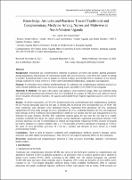| dc.description.abstract | Traditional and complementary medicine is globally accepted and steadily gaining popularity
among populations. The practices of conventional health care workers toward it vary from one country or setting
to another. Limited literature exists on practices of health workers towards this form of medicine in low income
settings especially in Africa where it is widely used with limited collaboration, integration and regulation.
Purpose: To determine the prevalence and determinants of traditional and complementary medicine practices as
well as health problems and reasons for its use among nurses and midwives in North Western Uganda.
Materials & Methods: We used a descriptive and analytical cross-sectional design. Data was collected using
self-administered structured questionnaires that were distributed to a sample of 300 nurses and midwives drawn
from 6 hospitals. Descriptive statistics, chi squared and multiple binary logistic regression analysis were used for
analysis.
Results: Of all the respondents, 147 (54.9%) had personally ever used traditional and complementary medicine,
69 (25.7%) had personally used it in the past 12 months, 84 (31.3%) had ever recommended use of TCM. The
most commonly used therapies were: herbalism (78.2%), traditional birth attendance (67.3%), nutritional
supplements (67.3%), body massage (53.1%), spiritualism (24.5%), traditional dentistry (21.1%) and traditional
bone setting (14.3%). Traditional and complementary medicine was mainly used for pain management (53.1%)
followed by acute diseases (49.6%). The commonest reasons given for use were the fact that it is readily
available, accessible and cheap. Chi square analysis showed statistically significant associations between TCM
practices (personal use and recommendation to others) and respondents religion (p=0.046), location of hospital
(p=0.002), presence of a family member who is a TCM provider (p=0.001), attendance of training on TCM in
the years of work (p=0.001), provision of TCM as a business and duration of years served as a health
professional (p=0.029).
Conclusions: There is need to improve traditional and complementary medicine practices amongst nurses,
midwives and other health care professionals. This will avert the negative/undesired effects in the community. | en_US |


